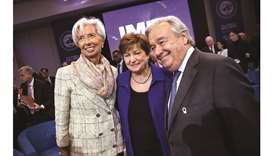Qatar to be a $225bn economy by 2020

Qatar is expected to be a $225bn economy by 2020, thus offering immense investment potential to foreign investors, as Doha eyes substantial inflow of foreign direct investment (FDI). The future of Qatar’s economy, as well as the FDI potential, was highlighted by senior officials from the Qatar Financial Center (QFC), Qatar Free Zones Authority (QFZA) and the Investment Promotion Agency of Qatar (IPAQ) at a recent event in New York.
“Qatar has invested significantly in its economy, generating gross domestic product growth that is expected to hit an impressive $225bn by 2020. This growth unlocked many investment opportunities in the country, and has already attracted the attention of foreign investors interested in establishing themselves in the Middle East,” said IPAQ chief executive Sheikh Ali al-Waleed al-Thani. Saud bin Abdullah al-Attiyah, deputy undersecretary for Economic Affairs, Ministry of Finance, said Qatar remains one of the world’s fastest-growing economies, with an abundance of investment opportunities across numerous sectors.
“This reflects the forward-thinking and progressive fiscal policies and legislative reforms introduced by Qatar that have already seen a positive impact, as noted by international ratings agencies including Moody’s and Standard and Poor’s, all of which underlines the nation’s attractiveness as an investment hub,” he added. Highlighting that Qatar’s regulatory, digital, entrepreneurial, and legislative frameworks off er a sustainable climate for global investors to prosper, Abdulla al-Misnad, deputy chief executive, QFZA, said the country’s free zones are committed to foster economic growth by focusing on sectors where Qatar has a “strong value proposition”.
“We aim to attract companies with willingness to play an active role in our vision towards a dynamic and diversified economy, and have the ability to penetrate large, fast-growing underserved global markets,” he said. Sarah al-Dorani, chief marketing officer, QFCA showcased Qatar as the ideal location (for global companies) to expand in the region. The event saw a range of experts discuss the outlook for foreign investors in Qatar; some of Qatar’s rapidly growing sectors including FDI in financial technology, as well as the upward investing trends seen in the past several years.
The event was hosted by Jason Kelly, New York Bureau Chief of Bloomberg and included a lineup of highly promi- nent speakers including ambassador Anne Patterson, President of the US- Qatar Business Council; Rachel Duan, president and chief executive of GE’s Global Growth Organisation; and James Zhan, Director of Investment and Enterprise at the United Nations Conference on Trade and Development.








